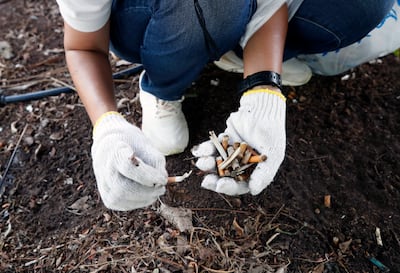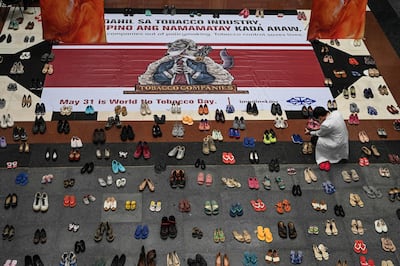The global spread of tobacco production and use is like gun proliferation in the US. It is one of those evils that causes widespread harm – such as lung cancer, the blocking of arteries and damage to unborn children – but also supports a large number of people and benefits many businesses.
In 2022, the global area under tobacco production was 4.3 million hectares and about 125 countries were producing the crop. Eighty percent of tobacco consumption is in low-and middle-income developing countries. Tobacco has created vested interests, which are difficult to control.
On May 31, the World Health Organisation and public health champions internationally came together on World No Tobacco Day. This year’s theme was “grow food, not tobacco”. The 2023 global campaign aims to raise awareness about alternative crop production and marketing opportunities for tobacco farmers, and encourages them to grow alternative sustainable, nutritious crops. It also aims to expose the tobacco industry’s efforts to interfere with attempts to substitute tobacco growing with sustainable crops, thereby contributing to the global food crisis. It is, indeed, a familiar tactic, also used by the US gun lobby.

In view of the food crisis created by Ukraine war, the WHO’s efforts are both timely and worthwhile. But there are many obstacles in the way; numerous and complex steps are needed to achieve “no tobacco”, and the pursuance of the goal is not for the fainthearted. Yet, given the adverse effects of tobacco on human and environmental health, it is worth examining the challenges and solutions in some detail.
First, the economic benefits to the major tobacco-producing countries, such as China, Brazil, India, Zimbabwe and Malawi, are considerable. Tobacco is a labour-intensive, drought-tolerant, hardy and short-duration crop that can be grown on soils where other crops cannot be cultivated profitably.
In India, the second-largest tobacco producer and exporter after China, an area of 0.45 million hectares (0.27 per cent of the country’s net cultivated area) produces about 750 million kilograms of tobacco leaf, according to the Indian Council of Agricultural Research. Grown under diverse conditions, in India alone, according to the ICAR, it provides at least 36 million people with a livelihood – six million farmers, 20 million agricultural labourers as well as the 10 million people who work in processing, manufacturing and exporting tobacco.
Integrated nutrient management, the withdrawal of potash application in northern and central black soils and reducing the phosphorus dose in several varieties have contributed to considerable savings in foreign exchange and have helped to conserve soil health. Micro-irrigation and fertigation systems have resulted in a considerable saving of water and nutrients, thereby preventing percolation and leaching losses. All these steps have increased the profitability of tobacco production. The same needs to happen in competing crops and livestock activities to incentivise farmers to switch from tobacco to other forms of agriculture. So far, research and development has not made the same contribution in other agricultural activities.
Governments need to keep stepping up research that increases the profitability of alternative crops, help sustain natural resources, increase public education to raise understanding about the adverse effects of tobacco use, increase taxes on tobacco products to make them less attractive to consumers and use the resources raised from such taxes for more useful purposes.

Second, major consumers and producers need to make collective agreements that they adhere to, rather than take advantage of each other’s tobacco-control strategies in a highly competitive world trade environment.
Cheng Li, a non-resident senior fellow in the Foreign Policy programme at the Brookings Institute, argues that the high prevalence of tobacco use in China and the scale of its tobacco industry is not only its single most serious public health problem, but also the ultimate test case for the global tobacco-control campaign.
He contrasts China’s amazing economic growth with its rapidly growing tobacco industry at home and abroad, as well as its ongoing smoking-related health crisis, with 1.2 million deaths in 2018 projected to reach two million by 2025. He argues that an effective campaign to get the country off smoking, despite daunting challenges and deep-rooted institutional barriers, has the potential to change the course of the tobacco epidemic in the world’s second-most populous country and lead to better health outcomes internationally.

Mr Li also provides a political map of China’s tobacco industry and its main stakeholders for the next phase of the campaign. He attributes slow acknowledgement of the devastating public health crisis primarily to tobacco being one of the largest sources of tax revenue – it accounts for between 7 and 10 per cent of total annual fiscal revenues, “like other fast-growing sectors such as real estate and petroleum”.
The tobacco revenue is also important in neighbouring Japan, where, according to research published last year, since 1985 combined revenue from national and local cigarette taxes has rarely fallen below $18.2 billion. In Brazil, itself a major tobacco producer, total tax revenue collected from tobacco-related products in 2018 was worth about $2.78 billion.
Anti-smoking campaigners believe pushing the notion that low-tar cigarettes are safer than regular cigarettes have become the tobacco promoters’ main strategy against tobacco control. But many international tobacco companies have invested a lot of money and energy into the development and promotion of e-cigarettes as a less-harmful alternative to traditional cigarette smoking. Nevertheless, WHO has described these devices as “harmful to health and unsafe”.
Given the intertwined webs of political power, commercial incentives, institutional and regional interests, social relationships and cultural norms, experts, including Margaret Chan, former director general of the WHO – recommend a bottom-up strategy involving civil society organisations and citizens working jointly with government and the authorities to increase buy-in for reform policies and to make them sustainable.
Creating an agricultural alternative for farmers and economies tied to tobacco will not happen overnight, but with the right vision and political will, it can become a reality – leading to a more effective, ethical, and sustainable use of precious land resources and protecting human health.


